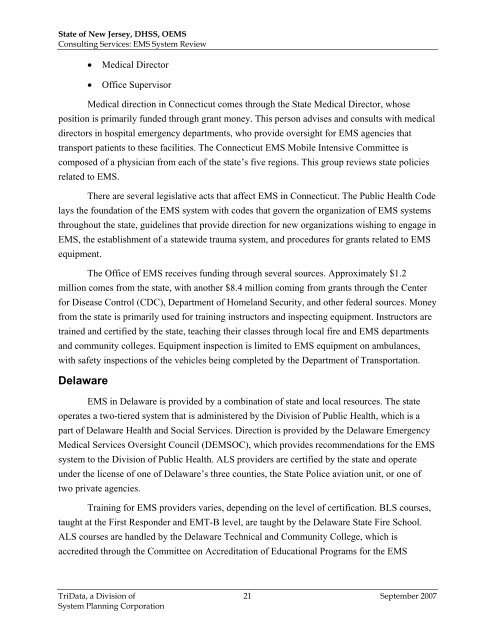EMS System Review - State of New Jersey
EMS System Review - State of New Jersey
EMS System Review - State of New Jersey
- No tags were found...
Create successful ePaper yourself
Turn your PDF publications into a flip-book with our unique Google optimized e-Paper software.
<strong>State</strong> <strong>of</strong> <strong>New</strong> <strong>Jersey</strong>, DHSS, O<strong>EMS</strong>Consulting Services: <strong>EMS</strong> <strong>System</strong> <strong>Review</strong>• Medical Director• Office SupervisorMedical direction in Connecticut comes through the <strong>State</strong> Medical Director, whoseposition is primarily funded through grant money. This person advises and consults with medicaldirectors in hospital emergency departments, who provide oversight for <strong>EMS</strong> agencies thattransport patients to these facilities. The Connecticut <strong>EMS</strong> Mobile Intensive Committee iscomposed <strong>of</strong> a physician from each <strong>of</strong> the state’s five regions. This group reviews state policiesrelated to <strong>EMS</strong>.There are several legislative acts that affect <strong>EMS</strong> in Connecticut. The Public Health Codelays the foundation <strong>of</strong> the <strong>EMS</strong> system with codes that govern the organization <strong>of</strong> <strong>EMS</strong> systemsthroughout the state, guidelines that provide direction for new organizations wishing to engage in<strong>EMS</strong>, the establishment <strong>of</strong> a statewide trauma system, and procedures for grants related to <strong>EMS</strong>equipment.The Office <strong>of</strong> <strong>EMS</strong> receives funding through several sources. Approximately $1.2million comes from the state, with another $8.4 million coming from grants through the Centerfor Disease Control (CDC), Department <strong>of</strong> Homeland Security, and other federal sources. Moneyfrom the state is primarily used for training instructors and inspecting equipment. Instructors aretrained and certified by the state, teaching their classes through local fire and <strong>EMS</strong> departmentsand community colleges. Equipment inspection is limited to <strong>EMS</strong> equipment on ambulances,with safety inspections <strong>of</strong> the vehicles being completed by the Department <strong>of</strong> Transportation.Delaware<strong>EMS</strong> in Delaware is provided by a combination <strong>of</strong> state and local resources. The stateoperates a two-tiered system that is administered by the Division <strong>of</strong> Public Health, which is apart <strong>of</strong> Delaware Health and Social Services. Direction is provided by the Delaware EmergencyMedical Services Oversight Council (D<strong>EMS</strong>OC), which provides recommendations for the <strong>EMS</strong>system to the Division <strong>of</strong> Public Health. ALS providers are certified by the state and operateunder the license <strong>of</strong> one <strong>of</strong> Delaware’s three counties, the <strong>State</strong> Police aviation unit, or one <strong>of</strong>two private agencies.Training for <strong>EMS</strong> providers varies, depending on the level <strong>of</strong> certification. BLS courses,taught at the First Responder and EMT-B level, are taught by the Delaware <strong>State</strong> Fire School.ALS courses are handled by the Delaware Technical and Community College, which isaccredited through the Committee on Accreditation <strong>of</strong> Educational Programs for the <strong>EMS</strong>TriData, a Division <strong>of</strong> 21September 2007<strong>System</strong> Planning Corporation



